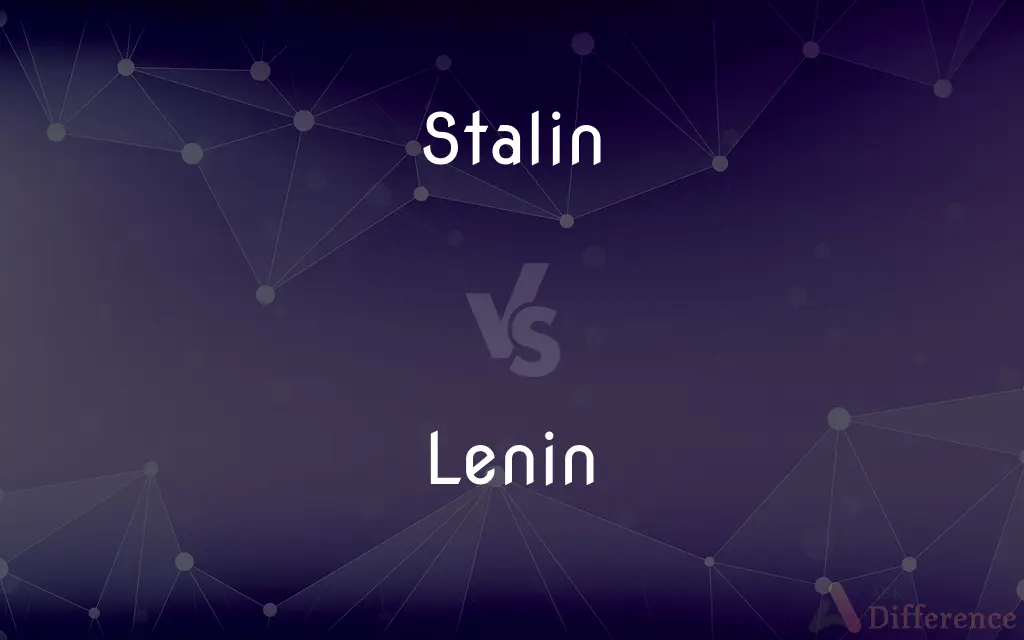Stalin vs. Lenin — What's the Difference?
By Tayyaba Rehman & Maham Liaqat — Updated on March 24, 2024
Stalin focused on centralized power and industrialization, enforcing policies through coercion. Lenin, the architect of the Soviet state, emphasized revolutionary theory and proletarian dictatorship.

Difference Between Stalin and Lenin
Table of Contents
ADVERTISEMENT
Key Differences
Stalin is best known for his role in the rapid industrialization of the Soviet Union and the establishment of a strong central government. His methods often involved the use of force, mass surveillance, and a totalitarian regime to eliminate opposition. Whereas Lenin, as the leader of the Bolshevik Revolution, laid the groundwork for a communist state, focusing on Marxist-Leninist ideology and the need for a vanguard party to lead the proletariat to revolution.
While Stalin's rule is marked by the collectivization of agriculture, which led to widespread famine and suffering, Lenin implemented the New Economic Policy (NEP), a temporary retreat from full socialism to a mixed economy, in an attempt to rebuild the war-torn economy. This shows Stalin's preference for harsh, immediate measures over Lenin's more pragmatic approach.
Stalin's foreign policy was characterized by a combination of cynicism and pragmatism, aiming to secure the Soviet Union's borders and spread communism globally, leading to tensions in international relations. On the other hand, Lenin believed in the international revolution but was more focused on consolidating power within the newly formed Soviet state, demonstrating a more inward-looking approach initially.
Under Stalin, the Communist Party became the sole center of power, with the cult of personality and extensive purges to eliminate perceived threats. In contrast, Lenin had a more collective leadership style, despite also suppressing opposition, indicating Stalin's shift towards an authoritarian regime.
Stalin's educational and social policies aimed at creating a homogeneous society loyal to the state, with an emphasis on Soviet nationalism. Lenin, while also focusing on literacy and education, was more inclined towards fostering a class-consciousness to support the communist cause, reflecting a difference in their social engineering approaches.
ADVERTISEMENT
Comparison Chart
Political Ideology
Stalinism: centralized, totalitarian
Marxism-Leninism: revolutionary, state-controlled
Economic Policies
Rapid industrialization, collectivization
New Economic Policy (NEP), mixed economy
Approach to Opposition
Purges, extreme repression
Suppression, but less extensive than Stalin
Leadership Style
Authoritarian, cult of personality
Collective leadership, more democratic within party
Foreign Policy
Pragmatic, security-focused
International revolution, but pragmatic consolidation
Compare with Definitions
Stalin
Created a cult of personality around himself.
Stalin's image was omnipresent in the USSR, symbolizing his absolute power.
Lenin
Founder of the Bolshevik party and leader of the October Revolution.
Lenin's writings on revolution inspired generations of communists.
Stalin
Implemented the Five-Year Plans to industrialize the Soviet Union.
Stalin's Five-Year Plans drastically increased Soviet industrial output.
Lenin
Established the New Economic Policy to revive the Russian economy.
Lenin's NEP was a strategic retreat from pure communism to ensure the survival of the Soviet state.
Stalin
Advocated for socialism in one country.
Stalin diverged from Lenin by emphasizing the importance of building communism in the USSR first.
Lenin
Introduced the concept of a vanguard party.
Lenin believed that a well-organized party was essential to guide the proletariat.
Stalin
Leader of the Soviet Union known for his authoritarian governance.
Stalin's rule was marked by the Great Purge, where millions were persecuted.
Lenin
Advocated for proletarian internationalism.
Lenin's vision included a worldwide communist revolution.
Stalin
Known for his role in WWII as a ruthless but effective leader.
Stalin's leadership was crucial to the Soviet victory in WWII.
Lenin
Russian founder of the Bolsheviks and leader of the Russian Revolution and first head of the USSR (1870-1924)
Stalin
Russian leader who succeeded Lenin as head of the Communist Party and created a totalitarian state by purging all opposition (1879-1953)
Common Curiosities
What is Stalinism?
Stalinism refers to Stalin's practices and policies, including rapid industrialization, collectivization, and political repression.
How did Stalin and Lenin's economic policies differ?
Stalin enforced rapid industrialization and collectivization, while Lenin introduced the NEP for economic recovery and a mixed economy approach.
What was the New Economic Policy (NEP)?
The NEP was a policy implemented by Lenin to reintroduce limited capitalist elements into the Soviet economy.
What was the Great Purge?
The Great Purge, under Stalin, was a campaign of political repression, resulting in the execution and imprisonment of millions.
How did Lenin and Stalin view opposition?
Both suppressed opposition, but Stalin's methods were far more brutal and extensive, including widespread purges.
What is Marxism-Leninism?
Marxism-Leninism is the communist ideology based on the theories of Marx and Lenin, focusing on the role of the vanguard party and proletarian dictatorship.
What was the cult of personality?
The cult of personality refers to the idealization and glorification of a leader, as seen with Stalin in the Soviet Union.
What was Stalin's role in WWII?
Stalin led the Soviet Union through WWII, playing a key role in the defeat of Nazi Germany.
How did foreign policies of Stalin and Lenin differ?
Lenin was more focused on supporting international revolutions at first, whereas Stalin's foreign policy was pragmatic and security-focused.
What were the Five-Year Plans?
The Five-Year Plans were a series of nationwide economic plans in the Soviet Union initiated by Stalin to rapidly industrialize the country.
How did Lenin and Stalin's leadership styles differ?
Lenin's style was more collective and within the Communist Party's framework, while Stalin established an authoritarian regime centered around his person.
Did Stalin and Lenin have the same goals?
While both aimed to establish and spread communism, their methods and approaches differed significantly.
Share Your Discovery

Previous Comparison
Action vs. Obligation
Next Comparison
Superstratum vs. SubstratumAuthor Spotlight
Written by
Tayyaba RehmanTayyaba Rehman is a distinguished writer, currently serving as a primary contributor to askdifference.com. As a researcher in semantics and etymology, Tayyaba's passion for the complexity of languages and their distinctions has found a perfect home on the platform. Tayyaba delves into the intricacies of language, distinguishing between commonly confused words and phrases, thereby providing clarity for readers worldwide.
Co-written by
Maham Liaqat













































